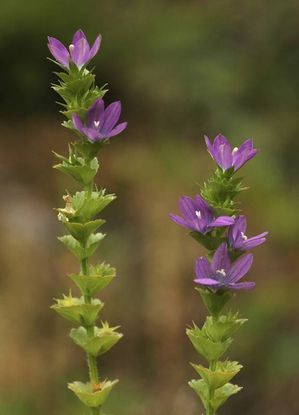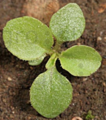Difference between revisions of "Triodanis perfoliata"
(Created page with 'Triodanis perfoliata seeds. Photo by Lisa Hintz First overview block: Scientific Name, Synonyms, Family, English Names, Oth…') |
(→Description) (Tag: VisualEditor) |
||
| (13 intermediate revisions by 3 users not shown) | |||
| Line 1: | Line 1: | ||
| − | + | *Scientific Name: ''Triodanis'' ''perfoliata'' | |
| − | + | ||
| − | + | ||
| − | + | ||
| − | + | ||
| − | + | ||
| − | + | ||
| − | + | ||
| − | + | ||
*Family: Campanulaceae | *Family: Campanulaceae | ||
| − | * | + | *Common Names: Venus' looking glass, clasping bellwort |
| − | * | + | *Previous names and misapplications: ''Specularia perfoliata'' |
| + | ---- | ||
| + | [[File:TRIPER4.jpg|thumb|416x416px|''Triodanis perfoliata''. Photo Ben Legler 2011]] | ||
| + | ===Taxonomy=== | ||
| + | {{Taxobox | ||
| + | | name = | ||
| + | | regnum = [[Plant]]ae | ||
| + | | subregnum = Viridiplantae | ||
| + | | phylum = Tracheophyta | ||
| + | | subphylum= Spermatophytina | ||
| + | | classis = Magnoliopsida | ||
| + | | subclassis = Asteranae | ||
| + | | ordo = Asterales | ||
| + | | familia = Campanulaceae | ||
| + | | genus = ''Triodanis'' Raf ex. Greene | ||
| + | | species = '''''Triodanis perfoliata''''' (L.) Nieuwl. | ||
| + | | subspecies = | ||
| + | | synonyms = *''Legousia perfoliata'' (L.) Britton | ||
| + | *''Specularia perfoliata'' (L.) A. DC. | ||
| + | }}<ref>Interagency Taxonomic Information System. | ||
| + | Retrieved from https://www.itis.gov/servlet/SingleRpt/SingleRpt?search_topic=TSN&search_value=34615#null</ref> | ||
| + | |||
| + | ===Description=== | ||
| + | Annual herb growing from taproot<ref name=":0">Hitchcock, C. L., Cronquist, A., Giblin, D., | ||
| + | & Legler, B. et al. (2018). ''Flora of the Pacific Northwest: an | ||
| + | illustrated manual''. Seattle: University of Washington Press. p. 517.</ref> with axillary purple flowers, to 60 cm tall.<ref name=":1">WTU Herbarium, Burke Museum, | ||
| + | & University of Washington. (n.d.). Retrieved from https://biology.burke.washington.edu/herbarium/imagecollection/taxon.php?Taxon=Triodanis%20perfoliata</ref> Stems erect, usually simple or sometimes branched, hairy.<ref name=":2">E-Flora | ||
| + | BC: Electronic Atlas of the Flora of British Columbia. Retrieved from https://linnet.geog.ubc.ca/Atlas/Atlas.aspx?sciname=Triodanis%20perfoliata</ref> Leaves cauline, alternate, clasping, cordate to rotund, 0.5-3 cm long, lowest leaves narrow and short-petiolate.<ref name=":2" /> Flowers axillary on upper stem with 1 to several in each axil,<ref name=":1" /> radially symmetrical; calyx, corolla and androecium inserted on hypanthium; sepals 5, narrowly triangular, sometimes connate at base; corolla 5-lobed, rotate,<ref name=":0" /> 8-13 mm long;<ref name=":2" /> stamens 5;<ref name=":1" /> pistil 3-carpellate,<ref>Zomlefer, W. (1994). ''Guide to Flowering Plant Families''. Chapel Hill, NC: The University of North Carolina Press. p. 211.</ref> with 1 to 3-lobed style, inferior ovary becoming an elliptic to oblong capsule, dehiscent by distal pore.<ref name=":0" /> | ||
| + | |||
| + | ===Bloom Period=== | ||
| + | April - June<ref name=":1" /> | ||
| + | |||
| + | ===Distribution=== | ||
| + | Southern British Columbia to California; mainly west of the Cascade crest in Washington, both sides of Cascades in Oregon and California.<ref name=":0" /> | ||
| + | |||
| + | ===Habitat=== | ||
| + | Common weed species growing in waste places, disturbed sites, pastures, prairies, and roadsides <ref name="Seyermark">Seyermark, 1963</ref>. Dry woods and open sites (Justice and Bell, 1968). Dry to moderately dry soils <ref name="Douglas et al">Douglas et al, 2002</ref>. | ||
| + | ===Uses=== | ||
| + | ====Site Rehabilitation==== | ||
| + | Useful for attracting pollinating insects. Fibrous roots have the capacity to stabilize disturbed soils <ref name="USDA">USDA, 2002</ref> <ref name="Haddock">Haddock, 2000</ref> | ||
| + | ====Wildlife==== | ||
| + | Attracts mega-chilid bee, sphecid wasps, leatherwing beetles <ref name="Gara and Meunhow">Gara and Meunhow, 1990</ref> | ||
| + | ====Landscaping==== | ||
| + | Annual species but possible to mass in beds for pleasing purple colour. | ||
| + | ====First Nations==== | ||
| + | Liquid compound of root taken for dyspepsia from overeating; Infusion of roots taken and used as a bath for dyspepsia; Use as an emetic.<ref>Native American Ethnobotany Database. (n.d.). Retrieved from | ||
| + | <nowiki>http://naeb.brit.org/uses/search/?string=triodanis</nowiki></ref> | ||
| − | == | + | ===Propagation=== |
| + | ====Seed Propagation==== | ||
| + | *Seed collection time: June-August | ||
| + | *Crop intervals: Annual | ||
| + | ====Fruit and Seed Collection and Extraction==== | ||
| + | Collect capsules by hand into collection bags. Allow to dry, and then shake collection bags to release seeds. | ||
| + | ====Fruit/Seed Dormancy and Treatment==== | ||
| + | Sow seeds outdoors in flats or containers in late summer or early fall and allow dormancy to be broken naturally. | ||
| + | ===Outplanting Characteristics and Requirements=== | ||
| + | Plant in full sun to partial shade in coarse-textured, free-draining soils. | ||
| − | |||
| − | == | + | ===Photo Gallery=== |
| − | + | <gallery> | |
| − | + | File: TRIPER1.jpg |Courtesy of CNLM | |
| + | File: TRIPER2.png|T. perfoliata seedling courtesy of CNLM | ||
| + | File: TRIPER3.jpg | 2004 Rod Gilbert | ||
| + | File: TRPE LisaHintz sd 2012.jpg | T. perfoliata seeds. Photo Lisa Hintz | ||
| + | </gallery> | ||
| − | == | + | ===References=== |
| − | + | <references /> | |
| − | + | [http://www.goert.ca/propagation_guidelines/forbs/triodanis_perfoliata Garry Oak Ecosystems Recovery Team Propagation Guidelines]<br><br> | |
| − | + | ||
Latest revision as of 11:35, 30 June 2021
- Scientific Name: Triodanis perfoliata
- Family: Campanulaceae
- Common Names: Venus' looking glass, clasping bellwort
- Previous names and misapplications: Specularia perfoliata
Contents
Taxonomy
| Scientific classification | |
|---|---|
| Kingdom: | Plantae |
| Subkingdom: | Viridiplantae |
| Phylum: | Tracheophyta |
| Subphylum: | Spermatophytina |
| Class: | Magnoliopsida |
| Subclass: | Asteranae |
| Order: | Asterales |
| Family: | Campanulaceae |
| Genus: | Triodanis Raf ex. Greene |
| Species: | Triodanis perfoliata (L.) Nieuwl. |
| Synonyms | |
| |
Description
Annual herb growing from taproot[2] with axillary purple flowers, to 60 cm tall.[3] Stems erect, usually simple or sometimes branched, hairy.[4] Leaves cauline, alternate, clasping, cordate to rotund, 0.5-3 cm long, lowest leaves narrow and short-petiolate.[4] Flowers axillary on upper stem with 1 to several in each axil,[3] radially symmetrical; calyx, corolla and androecium inserted on hypanthium; sepals 5, narrowly triangular, sometimes connate at base; corolla 5-lobed, rotate,[2] 8-13 mm long;[4] stamens 5;[3] pistil 3-carpellate,[5] with 1 to 3-lobed style, inferior ovary becoming an elliptic to oblong capsule, dehiscent by distal pore.[2]
Bloom Period
April - June[3]
Distribution
Southern British Columbia to California; mainly west of the Cascade crest in Washington, both sides of Cascades in Oregon and California.[2]
Habitat
Common weed species growing in waste places, disturbed sites, pastures, prairies, and roadsides [6]. Dry woods and open sites (Justice and Bell, 1968). Dry to moderately dry soils [7].
Uses
Site Rehabilitation
Useful for attracting pollinating insects. Fibrous roots have the capacity to stabilize disturbed soils [8] [9]
Wildlife
Attracts mega-chilid bee, sphecid wasps, leatherwing beetles [10]
Landscaping
Annual species but possible to mass in beds for pleasing purple colour.
First Nations
Liquid compound of root taken for dyspepsia from overeating; Infusion of roots taken and used as a bath for dyspepsia; Use as an emetic.[11]
Propagation
Seed Propagation
- Seed collection time: June-August
- Crop intervals: Annual
Fruit and Seed Collection and Extraction
Collect capsules by hand into collection bags. Allow to dry, and then shake collection bags to release seeds.
Fruit/Seed Dormancy and Treatment
Sow seeds outdoors in flats or containers in late summer or early fall and allow dormancy to be broken naturally.
Outplanting Characteristics and Requirements
Plant in full sun to partial shade in coarse-textured, free-draining soils.
Photo Gallery
References
- ↑ Interagency Taxonomic Information System. Retrieved from https://www.itis.gov/servlet/SingleRpt/SingleRpt?search_topic=TSN&search_value=34615#null
- ↑ 2.0 2.1 2.2 2.3 Hitchcock, C. L., Cronquist, A., Giblin, D., & Legler, B. et al. (2018). Flora of the Pacific Northwest: an illustrated manual. Seattle: University of Washington Press. p. 517.
- ↑ 3.0 3.1 3.2 3.3 WTU Herbarium, Burke Museum, & University of Washington. (n.d.). Retrieved from https://biology.burke.washington.edu/herbarium/imagecollection/taxon.php?Taxon=Triodanis%20perfoliata
- ↑ 4.0 4.1 4.2 E-Flora BC: Electronic Atlas of the Flora of British Columbia. Retrieved from https://linnet.geog.ubc.ca/Atlas/Atlas.aspx?sciname=Triodanis%20perfoliata
- ↑ Zomlefer, W. (1994). Guide to Flowering Plant Families. Chapel Hill, NC: The University of North Carolina Press. p. 211.
- ↑ Seyermark, 1963
- ↑ Douglas et al, 2002
- ↑ USDA, 2002
- ↑ Haddock, 2000
- ↑ Gara and Meunhow, 1990
- ↑ Native American Ethnobotany Database. (n.d.). Retrieved from http://naeb.brit.org/uses/search/?string=triodanis





